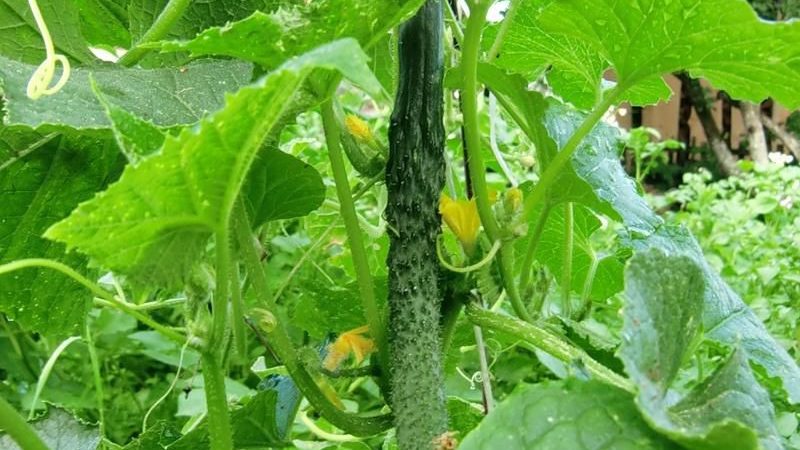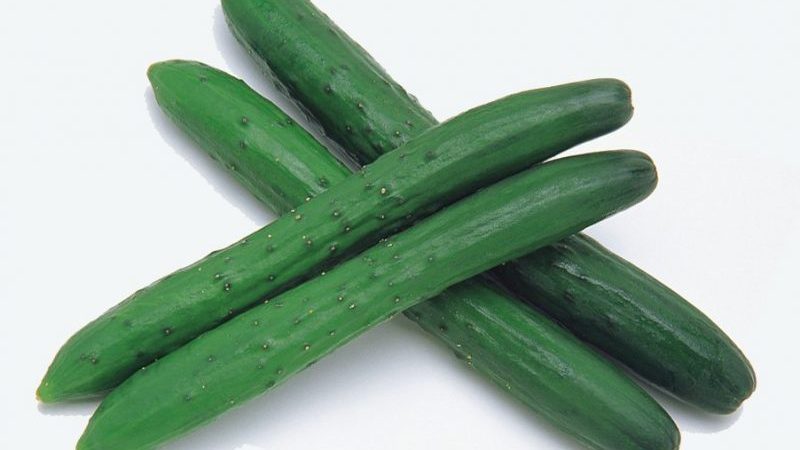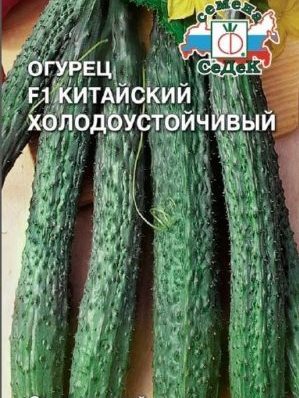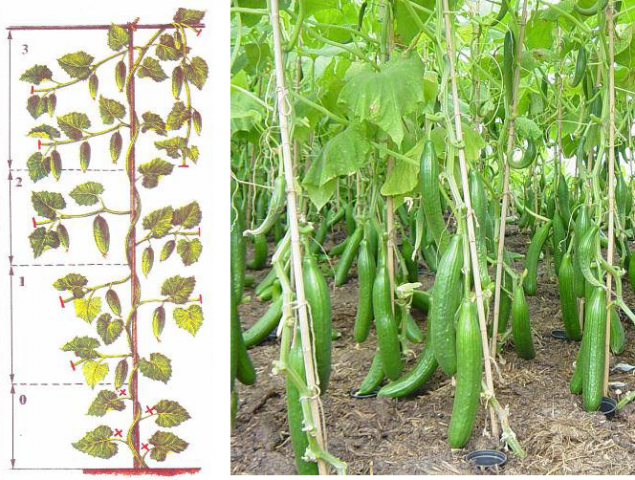What is the uniqueness of Chinese cucumber and how to get a decent harvest?
Chinese cucumbers are no longer perceived as exotic and even compete with traditional varieties from Russian beds. People with experience in growing "Chinese" note the gigantic size of the fruit, early maturity, high yield and resistance to heat and cold.
What other advantages do Chinese cucumbers have, how to grow them in open and closed ground, how to feed them, whether it is necessary to pinch them and from what diseases to protect - you will get answers to these and other questions in the article.
The content of the article
general description
Unlike conventional varieties, the Chinese bush grows up to 4 m. Their fruits reach 80-90 cm in length and 8 cm in diameter. Chinese cucumbers do not require special growing conditions and take root in any soil. They are able to withstand temperatures up to + 40 ° С. At the same time, drought has little effect on productivity, however, the fruits will be bitter if they really did not have enough water.
Attention! Bushes can be cross-pollinated with other varieties growing nearby.
 Cucumbers are grown both in the greenhouse and in the open field. Produce abundantly, up to four fruits of the same size are formed on one plant, which ripen at the same time. Vegetables are classified as high-yielding: up to 10 kg of fruits are harvested from one bush.
Cucumbers are grown both in the greenhouse and in the open field. Produce abundantly, up to four fruits of the same size are formed on one plant, which ripen at the same time. Vegetables are classified as high-yielding: up to 10 kg of fruits are harvested from one bush.
Their popularity has increased due to early maturity: it occurs 30 days after the appearance of the first leaves from the ground. They are eaten mostly raw, and they must be eaten as soon as possible, otherwise they will wither and dry out due to loss of water.
The fruits of the Chinese cucumber are also suitable for conservation, but they are closed immediately or the next day after picking from the bush.
Popular varieties and hybrids
Most of the seeds are brought directly from the PRC. Let's consider the most popular cultures among consumers.
Emerald Stream
A variety of vigorous and weakly braided Chinese cucumbers. It is referred to as early ripe, it begins to bear fruit on the 48th day after the emergence of shoots from the ground. Productivity from 1 sq. m averages 6 kg. These cucumbers are grown in any conditions, both in open beds and in greenhouses, as well as at home. The size of the fruit reaches up to 50 cm in length and weighing up to 200 g. The variety is resistant to diseases, even powdery mildew is not afraid of it. Unpretentious in care, shade-tolerant and tolerates cold well.
Reference! This variety of Chinese cucumbers capable of self-pollination: during flowering, predominantly female flowers are formed. But it can also multiply with the help of bees, while the yield increases, and the fruits are deformed - this also happens as a result of growing a bush without support and a garter.
Up to five cucumbers can form on the bush at once. Thin fruits have an elongated cylindrical shape of dark green color. The peel is thin, not hard, covered with tubercles and white pubescence. Juicy and crunchy cucumbers with a small seed chamber, yet quite sweet in taste and with a pronounced aroma. They are mainly used for salads.
They are harvested at a length of 18-25 cm, because the longer fruits become thicker and turn yellow, which leads to a deterioration in taste.
Chinese snake F1

It belongs to the middle early cultures. He has powerful branchy bushes that grow very quickly and give a fairly large yield.
Reference! Parthenocarpic hybrid, self-pollinated. The fruits are arched and up to 50 cm long, like many Chinese varieties, they smell like melon or watermelon. They are eaten immediately after collection, otherwise the next day they will lose their taste, will be soft and watery.
The vegetables are dark green. They practically do not have seeds, are dense, fleshy, on the surface they have large infrequent tubercles.
Important! Hybrid was bred specifically for growing in greenhouse conditions. It is planted in open ground only in one case, when the average daily air temperature does not fall below + 25 ° C.
Chinese miracle

Cucumbers of this variety grow up to 4 m, have a powerful and sufficiently branched root system, their lashes are necessarily tied up. Cucumbers are cross-pollinated or themselves.
Fruits up to 60 cm long, even cylindrical, juicy green with infrequent tubercles. The weight of one cucumber can reach 650 g. The taste is not bitter, crispy and juicy with small seeds.
This variety is classified as late-ripening, vegetables will be ready for harvest 60-70 days after planting. They grow well and yield a harvest with good light and constant watering... However, they are unpretentious to care for and disease resistant.
Reference! Unlike other varieties, the Chinese miracle has an interesting feature. A piece of the desired length is cut from the cucumber growing on the branch, and the rest will continue to grow on the whip as usual.
Cucumbers are used both for raw consumption and for preservation.
Chinese frost and heat resistant F1

These hybrids are suitable for those gardeners who are just starting to get acquainted with an exotic vegetable. Crops tolerate high and low temperatures, as their names suggest.
The farmer's heat-resistant cucumber is mid-season. It takes up to 54 days from germination to harvesting the first crop. Plants are vigorous, branched with well-developed leaves. The crop is harvested before the frost. From one bush, 15 to 20 kg of cucumbers are harvested, with a weight of one fruit up to 120 g and a length of 35 to 55 cm.
Cucumbers of both varieties have a cylindrical shape, large pimples, dark green color, short white stripes in the upper part of the fruit. The pulp is tender, crispy, sweet and aromatic. They are eaten fresh or salted.
Reference! Hybrids bear fruit at high and low temperatures. Both crops have developed immunity to powdery mildew and fusarium wilt. Cucumbers keep well in the refrigerator for up to seven days.
A frost-resistant hybrid is planted immediately in the ground with seeds, but it also grows well in a greenhouse. It endures small frosts and is not afraid to grow in the shade.
White delicacy
This variety is considered one of the most delicious among Chinese cucumbers. It endures unfavorable weather conditions and all diseases that cucumbers are exposed to. Not afraid of sudden changes in temperature and humidity.
The variety got its name because of the color of the peel - it is white, with a small almost imperceptible yellow or green tint. It is thin and the flesh is fragrant and tender.
Reference! The length of the fruit does not exceed 15 cm, and the shape is cone-shaped, unlike other varieties of Chinese cucumbers.
Alligator F1
Refers to early maturing hybrids of Chinese selection. Ripens in up to 50 days. From 1 sq. m harvest 14-16 kg of crop. The fruit reaches a length of up to 40 cm and a weight of up to 300 grams. Fruiting until mid-autumn.
Reference! Alligator F1 cannot self-pollinate and needs insect pollination.
Vigorous bushes require a garter. 6-8 fruits ripen on one plant. The skin of the vegetable is similar to the skin of an alligator. Cucumbers are consumed fresh and used for preparations.
Shanghai fellow F1
It belongs to early ripening hybrids and grows great in a greenhouse, since it does not need insect pollination. A few bushes are enough to harvest a good harvest until October.The plant has unlimited stem growth, which is taken into account when planting.
Cucumbers are tasty and long, weighing up to 350 g. From 1 sq. M. m in the greenhouse harvested up to 13 kg of the crop. Resistant to infection with peronosporosis and fusarium. The food is mainly used for preparing salads.
How to grow
The rules for cultivating Chinese cucumbers are not much different from the cultivation of conventional varieties and hybrids. Suitable for growing in greenhouses and in the garden.
Features of growing in a greenhouse and open field
The main feature when growing all Chinese varieties and hybrids in the greenhouse and in the open field will be mandatory tying on strong trellises. This will help to get straight fruits, without kinks.
The culture is planted closer to each other, which saves space, but do not forget about the height of the stems when choosing a greenhouse.
They are irrigated every day with warm water. In the open field, when watering, natural precipitation is taken into account. Make sure the ground is always moist.
The soil for planting is prepared in advance since the fall, because the minerals and substances that enter the ground decompose within 4-5 months and only after that are well absorbed by the roots of plants. Fertilize the ground with humus and sawdust. In the spring, saltpeter is introduced 20-25 g per 1 sq. m. Superphosphate, potash and phosphorus fertilizers are also applied. Ash is added to increase the weight of the fruit.
Important! If you saturate the soil in the fall, then you will not need fertilizers during the cultivation process. When planting seeds or seedlings of Chinese cucumbers, observe the distance between the seedlings and the planting depth.
Sowing seeds and growing seedlings
Chinese cucumbers are planted directly by seeds or seedlings. Seeds and soil are prepared before planting.
Seed preparation for planting:
- Calibration is carried out, the seeds are lowered into the water and floating seeds are removed.
- Soak in a solution of potassium permanganate for an hour for disinfection.
- They are treated with stimulants, keeping them in them for up to 12 hours.
- Germinate by laying on wet gauze.
In the fall, humus and sawdust are introduced before digging up the soil. In greenhouses, the soil is laid out in two layers. Bottom layer: manure, straw and foliage, then humus. For every 10 kg of soil mixture, 15 g of superphosphate and 250 g of ash are added.
Sowing with seeds
After preparing the seeds, they are planted in the soil prepared in advance in the fall. If this has not been done, manure is introduced and the soil is mulched with sawdust. In southern latitudes, with an average daily temperature of at least + 13-15 ° C, seeds are planted in the ground without covering with a film.
In other latitudes, after planting the seeds, the holes are covered with a black film until the first leaves appear, after which it is removed for a while to harden the seedlings. When planting seeds in greenhouses, they do not cover with foil.
Important! When landing, warm water must be poured into the holes.
With this method of landing, some conditions are met:
- The distance between the holes should be at least 5 cm. The width between the rows is 50 cm. Three seeds are planted in each hole.
- They are planted to a depth of no more than 3-4 cm.
- Germinated seedlings are thinned out, leaving a distance of 10 cm between them.
- After the leaves appear on the bushes, they are broken through again, leaving the bushes at a distance of 25-30 cm.
Important! Thinning seedlings, they are cut off or plucked out, but not pulled out, otherwise the roots of the left sprout are damaged.
Growing seedlings
When growing seedlings of Chinese cucumbers, the soil is prepared in advance. To do this, mix:
- 6 parts of peat;
- 1 part sand;
- 1 part sawdust;
- 2 parts of humus.
And in early spring, at 10-15 April, the mixture is poured into containers with a diameter of 10-12 cm. Seeds prepared in advance are planted in two pieces in cups with moistened soil to a depth of 1.5 cm. Then they are covered with a film and removed to a warm place. ...
When the first shoots appear, the seedlings are moved to the windowsill and the film is removed. They are regularly watered and sprayed with water at a temperature of + 22 ... + 24 ° C. When the plants have three leaves, the seedlings are thinned out, leaving one strong seedling at a time.
Important! After 15-30 days, the seedlings are planted in a greenhouse. The plant should have at least nine leaves by this time. When planting seedlings, leave a distance between the seedlings.
Plant care
Chinese cucumbers have a long stem and not many side shoots: for this reason, they must be tied up.
Plant care includes:
- frequent watering;
- shallow loosening of the soil;
- weeding;
- obligatory tying of a whip;
- periodically fed.
When growing a crop in a greenhouse, plants are watered twice a week, in the beds, precipitation is taken into account.
Plants in greenhouses are fed twice: when flowering begins and during fruiting. Outdoor plants are not fertilized if fertilized in the fall. To increase the yield, it is sprayed with a urea solution.
Since the roots of Chinese cucumbers are close to the surface, they loosen the soil shallowly. Mulching is done so that the earth does not crack, and the water does not evaporate so quickly. Mulching is carried out with peat, fine herbal mixture or sawdust. As a result, oxygen will better penetrate the soil, preventing it from compaction.
Step by step instructions: how to form cucumbers
Scourges are formed as they grow. Supports for weaving are installed on the beds: trellises, mesh or stretched ropes. In the greenhouse, a vertical support will be enough, a central stem is tied to it, from which side shoots branch off. The first five branches from the root are cut off.
The photo shows the plants before and after molding.

Prevention of diseases and pests
Chinese cucumbers are resistant to most diseases, but some diseases and pests do not bypass them.
The most dangerous:
- spider mite;
- melon aphid;
- damage by sprout fly and cucumber gnat.
- powdery mildew;
- fungal anthracnose;
- bacteriosis, which is inherent only in this culture.
- fusarium or root rot;
- gray rot;
- brown spotting;
- cucumber mosaic;
Important! The culture is especially susceptible to powdery mildew and anthracnose; of the pests, the putin mite and melon aphid are dangerous. To protect the plant, preventive actions are taken in time.
Peroxide, ammonia, tobacco dust and turpentine are suitable for combating spider mites in the initial stages. If there are clear signs of damage, the plants are sprayed with infusions or decoctions of plants that contain deadly toxins for ticks. Such as datura, dandelion, calendula, onion and garlic.
To combat powdery mildew, plants are sprayed with Oxyhom (20 g per 10 l of water). This is done every two weeks in the evening.
To destroy melon aphids, plants are sprayed with Fitoverm (4-6 ml per bucket of water). Re-spraying is carried out after two weeks.
Fighting against fungal anthracnose, they use antifungal drugs and carry out prevention.
Fighting bacteriosis for treatment, use "Fitoflavin", "Cuproxat", "Gamair" and other drugs.
Fusarium is fought radically, removing the entire plant with the root, and after removal, the formed hole is watered with a solution of copper sulfate.
When gray rot appears, foliar feeding is stopped and the humidity in the greenhouse is reduced. Infected plants and fruits are removed, treated with fungicides.
To prevent plant diseases and attack by pests, cucumbers are sprayed with fungicides and other measures are taken:
- Keep the distance between plants.
- Do not allow stagnation of water in the ground.
- Mulch to prevent weeds.
- Sick lashes are immediately removed and destroyed. If it's too late, then remove the entire bush.
- Cucumbers are treated with a garlic solution and infusion of onion peels.
Reviews of gardeners
Even despite the fact that the Chinese cucumber belongs to an exotic culture, every day it is winning back its meters from ordinary cucumbers, which is reflected in the reviews.
Tamara, amateur gardener, Krasnodar Territory: «Chinese cucumbers were advised in the store - they promised that they would like them. Oddly enough, they did not lie. I planted them in July, 80% of the crops had risen in a week. It is very hot here in summer - up to 40 degrees in the shade, so the heat resistance of the variety is very useful. Ordinary cucumbers disappear, wither and dry, but Chinese ones at least. Cucumbers grow up to 45 cm, there are few seeds ”.
Benjamin, summer resident, Vladimir region: "I plant Chinese cucumbers with seedlings. Seeds sprout poorly in the ground. I pinch the lashes when they grow to the trellis. The variety practically does not branch out to the sides, so they are densely planted. The taste is excellent and it never tastes bitter, even when it's very hot outside. For a long time, the question haunted: why do Chinese cucumbers grow in a crochet and curl? I read that it happens because of a lack of potassium, fed it - even fruits went. "
Natalia K., 40 years old, summer resident, Moscow region: “Last year I drew attention to the Chinese disease-resistant variety. I bought it! Those that were planted directly into the ground sprouted better than ordinary soaked ones. On the third day in the greenhouse, instead of flowers, such long, good ovaries of these cucumbers appeared. Two more days passed and huge cucumbers grew in their place! During growth and fruiting, I did not notice any signs of disease! So I didn't have to spray them with anything, and they grew as they are, on unfertilized ground, and grew half a meter in length and weighing half a kilo! In a greenhouse, planting and maintenance does not require any difficulties. The result of these seeds suited me, I bought them again, and I will grow them again! The cost also allows! "
Conclusion
Chinese cucumbers are grown in different climates and soils, in almost any region of our country - they are unpretentious in care. They are practically not affected by diseases and pests, unlike ordinary cucumbers. But they also have their disadvantages - they are not stored for a long time and not all varieties can be preserved.
As practice shows, even a beginner can cope with their cultivation. And the harvest will delight you with its volume, original appearance, unusual smell and taste.